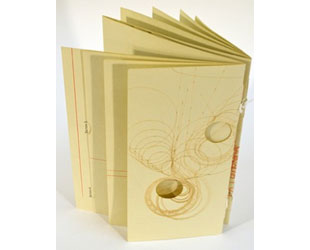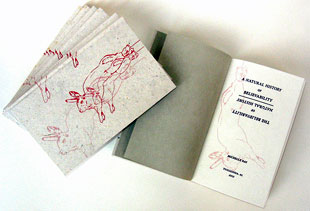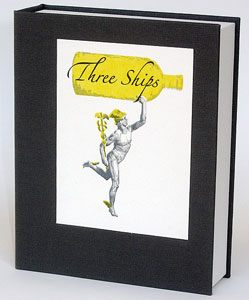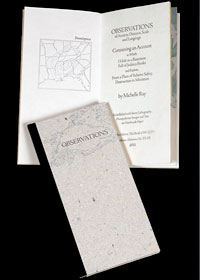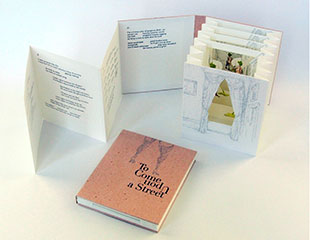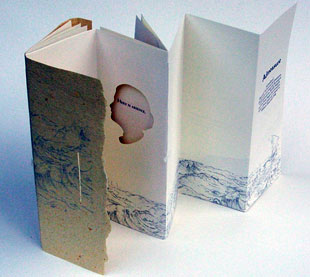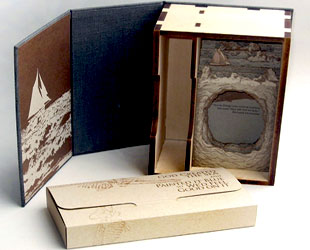
|
Michelle Ray ~
Florida |
|
| Michelle Ray: "I approach creating artists' books in the manner of a Victorian naturalist: by attempting to name the unnamed and gain an understanding of the world through documenting, cataloging, and connecting ideas." | |
| The Cave Protection Act of 2013 By Michelle Ray Tallahassee, Florida : Michelle Ray, 2013. Edition of 35. 7.5 x 6”; Text created with photopolymer plates, using Gill Sans typeface. Images generated with Rhino 3-D software and laser engraved. Printed on Talas Antique Endleaf paper. Enclosure is Canson Mi-Teintes and .080 board. Written, designed, printed, and bound by Michelle Ray at Small Craft Advisory Press and formLab, Facility for Arts Research, Florida State University. Numbered. Michelle Ray: "The Cave Protection Act of 2013 explores the meaning we insert into situations where direction in the form of signifiers is missing. "The idea for the project came from a documentary about Centralia, Pennsylvania. This mining town was destroyed when an underground fire broke out, creating sinkholes and sucking the town into the earth. I reference these events in the text, 'The community of Centralia, Pennsylvania became unified after the emergence of the sinkholes. / It started with a mine fire. The hot ground opened up and swallowed the town. The townspeople vaporized, condensed and came out pure – a distilled version of their former selves. / They began to ask, ‘WHAT IS COMMUNITY?' "I respond to how Centralia developed a strong identity because of its erasure. This sense of identity from erasure – of absence speaking volumes – struck a nerve since I had been through the 2011 Tuscaloosa, Alabama, tornado and saw how the town was simultaneously put on the map (in terms of media coverage) and wiped off the map (in terms of lost lives and property). "I worked from the text of The Federal Cave Protection Act of 1988, an oddly poetic bureaucratic document created to give sanctuary to bits of earth no longer present. Using this document as a point of departure, I created an inquiry into absence, domesticity, and memory. The piece’s aesthetic echoes that of government documents in its tabbed pages, hierarchical information organization, and machine generated illustration." $275 |
|
| A Natural History of Believability By Michelle Ray Tuscaloosa, Alabama: Michelle Ray, 2012. Edition of 50. 7.125 x 4.5 x .25"; 16 unnumbered pages. Images and text created with photopolymer plates. Case bound sewn binding. Paper-covered boards with embossed and printed images. In the edition of 50, 1 - 31 printed on handmade paper; 32 - 50 printed on machine made paper. Michelle Ray: "Natural History explores our fascination with facsimiles and the relationship between signs and the things they signify. Illustrated with a vanitas-style [a la memento mori, meant as a reminder of the ephemerality of life and the certainty of death] rabbit image as a recurring motif, this book’s brief essay looks at how things such as taxidermy and ornithological prints shape our relationship to the natural world. The viewer experiences a discord between representation and the real and is confronted with the question of which is more appealing." $ 160 machine made paper copies $ 175 handmade paper copies |
|
Three Ships * Note: Recently Associated Press noted that "Three bottles of rare, 19th-century Scotch found at Antarctic explorer Ernest Shackelton’s abandoned hut were returned to the polar continent Saturday after a distiller flew them to Scotland to recreate the long-lost recipe. Antarctica’s minus-22 Fahrenheit temperature was not enough to freeze the Mackinlay whisky, bottled in 1898." |
|
| Observations... By Michelle Ray Tuscaloosa, Alabama: Michelle Ray, 2011. Edition of 40. 7 x 3.5"; 16 pages. Images and text created with lithography and photopolymer plates on handmade cotton, abaca, and gampi papers. Quarter bound with title printed on cover. Michelle Ray: "This book was created in response to the April 27, 2011, tornado in Tuscaloosa, AL and the anxieties that ensued. Drawing its aesthetic and organizational inspiration from Victorian naturalist journals, Observations... is an exploration in how technical and scientific language arms the compulsive with tools for unorthodox ritual. The book is an exploration in miniaturization, anxiety and symbol, and the image and text move between the realms of micro- and macrocosm. The superstitious and the rational are interwoven throughout this autobiographical narrative, addressing the tension between those things that we believe and those that we know to be true." $285 |
|
To Come Upon a Street AB Gorham, bio: “AB Gorham is a book artist and writer from Montana and holds MFAs in Book Arts and Poetry from The University of Alabama. She is Assistant Professor of Book Arts and Papermaking at University of Nebraska Omaha. Recently, Gorham edited a collaborative reading experience of Frank Stanford’s The Battlefield Where the Moon Says I Love You, published by Third Man Books. Her poems have been published in Puerto Del Sol, The Call Center, American Letters and Commentary, DIAGRAM, and Gulf Coast, among others. Her artist books are collected nationally and ‘Unidentified Found Object Song’ was a semi-finalist for the 2022 MCBA Book Prize.” |
|
| Michelle Ray Out of Print Title: | |
Admeasure 8.125 x 3 x .25"; 24 pages. Accordion structure attached to back board. Text and image printed from photopolymer plates and linoleum blocks on handmade and Somerset Book papers. Housed in envelope with tab closure. |
|
| God Created the Sea and Painted it Blue so We'd Feel Good On It | |
By Michelle Ray 7 x 5.5 x 4.25" enclosure with custom compartments for documents and open fixed tunnel book. Images and text created with photopolymer plates, using Trajan and Optima typefaces on handmade cotton/abaca, French Construction and Neena Environment papers. Enclosure of linen and basswood. 11 pamphlets (7x3.5") plus fold out crew manifest (21 x 14" open) laid in envelope wrapper with slip and slot closure. Written, designed, and printed by Michelle Ray at The Small Craft Advisory Press, Florida State University as an MFA creative project for The University of Alabama's Book Arts Department. Michelle Ray: "While residing in the Deep South, I undertook a most wondrous adventure wherein I built a boat made entirely of cardboard and set about on an imaginary journey in the linoleum headwaters of my apartment. It started as cathartic play, it became this edition. "I first learned to use a map while sailing. Finding myself in a space with no landmarks, I had to trust my life to those unwieldy sheets of paper with their complex representations of the ever-changing seascape. In reference to the sea, this edition’s text states, 'There are no markers in this/ monochromatic/ parking lot.' In the absence of these markers, we become painfully aware of their significance. "This work is about experience, perception, memory and the space in between composed of symbol, sound and object. This is the space of mediation, the space where significant things happen; it is the ocean on which my imaginary crew and I sailed, the place for which there are no maps." Michelle Ray, colophon: "The enclosed account is partially true. It is also partially fabricated. But I assure you that all of it has been vigorously documented in a most honest manner. "The object's title is derived from a Bernard Moitessier quote. Motessier would have been the winner of the Sunday Times Golden Globe Race, the first 'round the world solo sailing competition. But as he rounded the final cape (he was in the lead) and headed north to the finish line, he had a change of heart and decided to sail on in the opposite direction. His rationale? In a note tucked in a film canister lobbed onto a passing ship's deck, he stated, '...I am happy at sea, and perhaps because I want to save my soul.'" |
|
Page last update: 11.09.2024
Home | About Us | Contact Us | New Arrivals | Fine Press & Artists' Books | Broadsides |Resource Books | Order/Inquiry
Copyright © 2021 Vamp & Tramp, Booksellers, LLC. All rights reserved.
